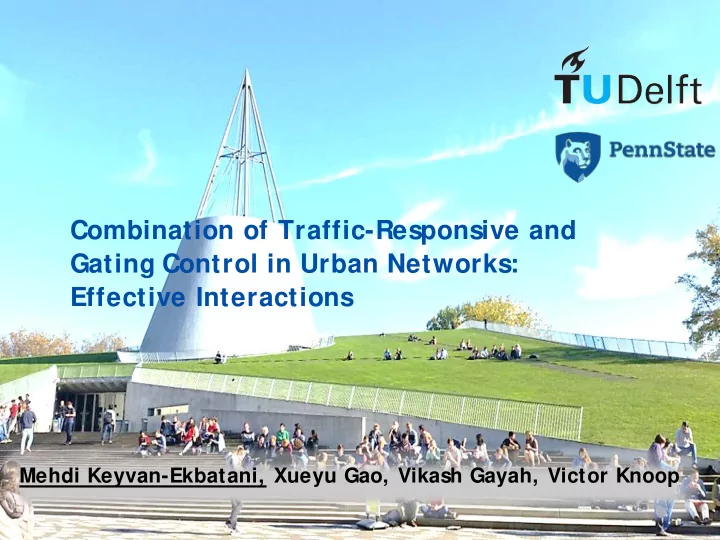

Combination of Traffic-Responsive and Gating Control in Urban Networks: Effective Interactions Mehdi Keyvan-Ekbatani, Xueyu Gao, Vikash Gayah, Victor Knoop Challenge the future 1
Main Contributions • Compared the impact s of adapt ive signal control and perimeter gating (only) • Examined the impacts of combining adaptive signal control and perimeter gating – The improved capacity and slightly higher critical accumulations on the MFD, as a result of traffic-responsive control, implemented for a more efficient gating • Implement ed in AIMS UN microsimulation of Chania urban network • Impacts quantified using overall urban traffic network efficiency Challenge the future 2
Introduction • Under over-saturated traffic conditions density-based adaptive signal control schemes have little t o no effect on a network (Gayah et al., 2014). • These strat egies may allow too much traffic to ent er from t he boundary of a network, if it is less congested, which can intensify queue spillbacks in the congested areas. • They also tend to act only after congestion begins to occur. • Urban traffic net works might be bet ter controlled by limiting the vehicle rate within the busiest parts of a network (using gating/ perimeter control). • The perimeter gating strat egy relies on macroscopic relationships between traffic variables measured network-wide (network accumulation vs. production; MFD or NFD) Challenge the future 3
NFD and Traffic-Responsive Control Strategies • Adaptive signal control can have posit ive effect s on the free flow and capacity portions of the NFD – Improved network capacity and higher critical accumulations can be achieved on the NFD • These improved macroscopic measures can result in more efficient gating Challenge the future 4
Combining Gating and Traffic- Responsive Strategies Challenge the future 5
Gating Control (Review) Controller Parameters ( ) ( ) ( ) ( ) ( ) = − − − − + − ˆ q k q k 1 K TTS k TTS k 1 K TTS TTS k g g P I TTS : Total Time S pent (Accumulation) Challenge the future 6
Volume-Based Traffic- Responsive Control • Fixed cycle length C : Cycle • S imple proportional algorithm L : lost time to allocate the available green i : approach time v : approach volume • Green allocation based on traffic volume measured at upstream detectors on each ( ) approach − v t 1 ( ) ( ) = − i g t C L . ∑ ( ) − i v t 1 i i Challenge the future 7
Simplified SCATS • Green time and total cycle lengths are variable • Appropriate cycle length is first select based on the volume ratio observed during the previous cycle. = − > STOPPER if C t ( ) MIN R t , ( 1) 0.4 = − < MIN if C t ( ) STOPPER and ( R t 1) 0.2 ( ) = − + − > C t min[ ( C t 1) STEP MAX , ] if R t ( 1) 0.95 − − − < max[ ( C t 1) STEP STOPPER , ] if R t ( 1) 0.85 − C t ( 1) otherwise ( ) • − MIN = 42 s d t 1 ( ) ( ) • = − − + G min : sum of minimum MAX = 132 s i ( ) . g t C t L G g ∑ ( ) • STOPPER = − s i min i min , 66 greens d t 1 • STEP = s 6 i d : approach demand i • = s g 6 i min , Challenge the future 8
Test-Bed (Chania Network) Challenge the future 9
Simulation Setup • The prot ect ed net work includes 28 signalized j unct ions and consist s of 165 links. • measurement s are collect ed every 90 seconds for t he gat ing cont rol • 4-hour t rapezoidal demand profile • Realist ic O-D flows applied. • 15 simulat ion runs carried out . • (1) Overall mean speed and (2) delay; (3) Maximum queue lengt h applied as performance indexes Challenge the future 10
Simulation Scenarios • S cenario 1: (no-gating) the traffic lights in the PN are controlled applying fix-time control signal plan. • S cenario 2: (no-gating) “ volume-based” traffic responsive control strategy is implemented to control all the traffic lights within PN. • S cenario 3: (no-gating) adaptive traffic control strategy “ modified S CATS ” is used for controlling the signalized j unctions within PN. • S cenario 4: Gating at the perimeter and fix-time control inside PN. • S cenario 5: Gating at the border and “ volume-based” for the rest of the traffic lights in the PN. • S cenario 6: Gating at the boundary and “ modified S CATS ” within PN Challenge the future 11
Traffic-Responsive Control Benefits on NFD No-Gating With Gating Challenge the future 12
Density Standard Deviation in all Scenarios Challenge the future 13
Overalll Network Performance Performan Scenario 1 Scenario 2 Scenario 3 Scenario 4 Scenario5 Scenario 6 ce Index delay 389 294 351 203 193 203 (sec/km) speed(Km/ 8 10 9 13 14 13 h) vehicle 12675 12913 12801 12924 12912 12923 out Gating Scenarios Challenge the future 14
Maximum Queue Length Challenge the future 15
Conclusions • The j oint implementation of perimeter gating control and adaptive traffic signal control examined. • Gating provides higher speeds and lower delays than adaptive signal control alone. • Adaptive traffic control increases the critical accumulat ion less car metered, shorter gating queues. • The combination offers advantages in case of multi-zone gating (less negative impact on vicinity traffic). Challenge the future 16
Thanks for listening! Email: M.Ekbatani@ tudelft.nl Challenge the future 17
Recommend
More recommend